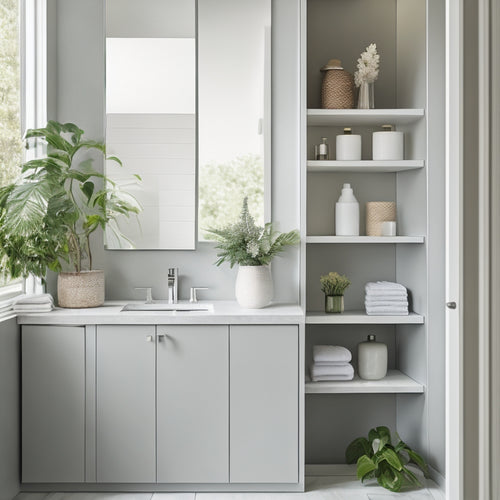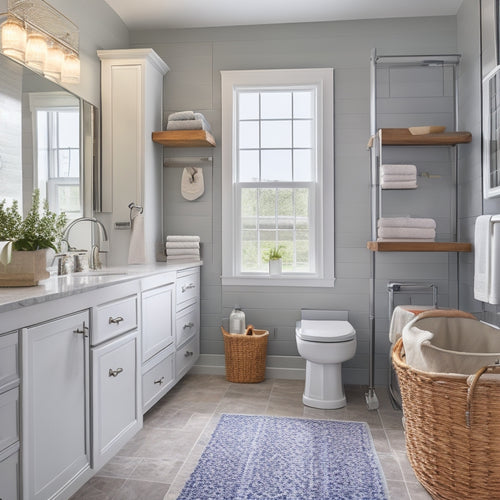
Crafters Rave Over Wall Organizer Tutorial
Share
I've fallen head over heels for wall organizers, and I'm not alone - the crafting community is abuzz with excitement over this innovative storage solution. As I explore the world of wall organizers, I realize that designing for style and function is essential. Building a responsive layout that adapts to various devices is important, and fine-tuning for mobile devices guarantees a seamless user experience. Bringing the tutorial to life with fabric selection and sewing steps is incredibly gratifying. With clear instructions and a supportive community, I'm enthusiastic to see how crafters put their own spin on this project - and I'm thrilled to explore the possibilities further.
Key Takeaways
• A well-designed wall organizer combines style and function, prioritizing color coordination for seamless decor integration and practical organization for efficient storage.
• A responsive layout is crucial, utilizing grid layouts and media queries to adapt to various devices and screen sizes for a seamless user experience.
• Mobile-friendly customizations ensure a visually appealing and accessible design on smaller screens, with adjustments to background size, footer/header, and layout tweaks.
• The hands-on process of creating the wall organizer is immersive and rewarding, with clear instructions guiding crafters through fabric selection, sewing, and project completion.
• Sharing the tutorial online sparks community engagement, inspiring crafters to experiment with fabric choices, share completed projects, and celebrate handmade craftsmanship.
Designing for Style and Function
When designing a wall organizer, I consider both style and function to create a cohesive and practical piece that not only serves its purpose but also adds a touch of personality to the room.
I prioritize color coordination to guarantee the organizer blends seamlessly with the surrounding decor. A well-coordinated color scheme can elevate the entire space and create a sense of harmony.
Practical organization is also key, as it enables users to efficiently store and retrieve their belongings. By balancing style and function, I can create a wall organizer that's both visually appealing and highly functional.
This thoughtful approach results in a piece that not only looks great but also makes life easier.
Building a Responsive Layout
To guarantee my wall organizer design translates seamlessly to various devices and screen sizes, I focus on building a responsive layout that adapts effortlessly to different environments. I achieve this by utilizing a grid layout, which allows me to define flexible grid tracks that adjust according to the screen size. To further enhance responsiveness, I employ media queries to apply specific styles based on different screen sizes and devices.
| Screen Size | Layout Adjustment |
|---|---|
| Large | Grid columns expand to 3 |
| Medium | Grid columns shrink to 2 |
| Small | Grid columns condense to 1 |
Mobile Friendly Customizations
I now focus on fine-tuning my design for mobile devices, where screen real estate is limited and user interactions are often finger-based. To guarantee a seamless user experience, I make targeted CSS adjustments for mobile view. This involves tweaking styling elements to ensure mobile compatibility.
I pay close attention to background size considerations, footer and header adjustments, and tab and widget layout for mobile. By doing so, I can assure that my wall organizer tutorial remains accessible and visually appealing on smaller screens.
With these mobile-friendly customizations, crafters can easily follow my instructions and create their own beautiful organizers, no matter the device they're using.
Bringing the Tutorial to Life
With my design and layout carefully crafted, I immerse myself in the hands-on process of creating my wall organizer.
I select fabrics that bring a pop of color and personality to my project, indulging in the joy of fabric choices.
Bringing creativity to life, I iron my fabrics, cut out the necessary pieces, and begin assembling the pockets.
As I sew, I feel a sense of accomplishment with each step, watching my wall organizer take shape.
The tutorial's clear instructions guide me through the process, and I'm thrilled to see my project come together.
With every stitch, I'm bringing my vision to life, and I can't wait to hang it on my wall and start organizing my space.
Community Love and Inspiration
As I share my finished wall organizer tutorial online, a wave of enthusiasm and gratitude washes over me, inspired by the outpouring of praise and appreciation from the crafting community.
I'm thrilled to see how crafters are embracing the project, experimenting with different fabric choices and project variations that showcase their unique styles. The user engagement has been incredible, with many sharing their completed projects and expressing gratitude for the inspiration.
It's heartwarming to see how this tutorial has brought people together, sparking creativity and motivation. I'm proud to be a part of this community that celebrates handmade craftsmanship and creative expression.
Frequently Asked Questions
Can I Use Different Fabric Weights for the Wall Organizer Project?
"I can definitely experiment with fabric blending and weight variation for my wall organizer project. While it's recommended to use similar weights, I can try mixing cotton and canvas for a unique look, just ensuring the stability of the pockets."
How Do I Adjust the Tutorial for a Larger or Smaller Organizer?
"I easily adjust the tutorial for custom sizing by considering space constraints, then altering the fabric cuts and pocket arrangements to fit my desired dimensions, ensuring a perfect fit for my unique wall organizer needs."
Are There Alternative Materials to Scrap Cardboard for the Project?
What's stopping me from getting creative with materials? I opt for eco-friendly alternatives like old cereal boxes or upcycled cardboard tubes instead of scrap cardboard, reducing waste and adding a personal touch to my organizer.
Can I Add Additional Features, Like Hooks or Small Shelves?
I can definitely add extra features to my organizer, like hooks or small shelves, by incorporating customizable compartments and hidden pockets to maximize storage and keep clutter at bay.
Is the Wall Organizer Suitable for Children or Heavy Usage?
As I contemplate utilizing the wall organizer for kids or heavy usage, I think about durability concerns and safety features - I'd want to guarantee sturdy materials and secure attachments to prevent accidents or damage.
Related Posts
-

Modern Bathroom Cabinetry for Small Bathrooms
When designing modern bathroom cabinetry for small spaces, your focus should be on maximizing storage while embracing...
-

Transform Your Bathroom With Clever Storage Hacks
Elevate your bathroom's functionality and style with clever storage hacks. Maximize space by utilizing the back of th...
-

Innovative Miro Applications: Beyond the Usual
Miro's capabilities surpass traditional boundaries, offering a domain of innovative applications waiting to be explor...


